In September 2020 after 20 years on the Boeing 777 – I commenced a Type Rating training course on a new aircraft type. This series of blog posts (Ha!) tracks my progress (or lack of) through that tumultuous exercise. Having trained (helped) many others through this exercise over the last 20 years – it was time to do it myself.
Originally, this was going to be a series. I was going to build posts as I went along through the course and document my progress towards completion.
Ha.
What I have found is that all the things I’ve said to my students in the past were very true for me. A Type Rating is a Fire Hose of information. In four weeks I completed:
- 12x days of ground school that include a dozen systems exams with a minimum 80% pass mark;
- 4x Fixed Base Sim Sessions
- 7x Full Flight Sim Sessions of Training
- 3x Full Flight Sim Check Sessions (Type Rating, Instrument Rating, Operator Check).
Interspersed were a few days off where we drove back out the the sim centre and sat in the device as much as we could to get ourselves across the flight deck and associated normal and non normal procedures.
There was no time for blogging.
Background – How did I get here?
 In early 2020 COVID-19 began it’s decimation of the World, taking along with it 90% of the Airline Industry. While the outcome was deadly for some, devastating for many – for me personally it meant 7 months of living off accumulated leave assisted (not really) by the Australia Government’s JobKeeper system, as well as some casual work producing Microsoft Excel spreadsheets (how the mighty have fallen …)
In early 2020 COVID-19 began it’s decimation of the World, taking along with it 90% of the Airline Industry. While the outcome was deadly for some, devastating for many – for me personally it meant 7 months of living off accumulated leave assisted (not really) by the Australia Government’s JobKeeper system, as well as some casual work producing Microsoft Excel spreadsheets (how the mighty have fallen …)
Speaking of Devastating – let’s return to the Airline Industry.
As I write this, approximately 4,000 people have lost their jobs at Virgin Australia – including the CEO. For me this came in mid August when it was announced that the new Virgin to emerge from the Crisis would not have an International arm – No 777’s, 330’s – so all the crew and related staff – gone. Coupled with this announcement was the elimination of the smaller turbo-prop ATR and that associated workforce as well. All this was preceded by the elimination of hundreds of Virgin NZ and Tiger staff months before. For me R-Day was October 3rd.
I find myself an International Pilot in a world where there is precious little international flying. The likelihood for employment prior to a meaningful recovery of international travel is exactly zero. From what I can see – International Travel is several billion doses of a successfully delivered vaccination away.
So much for International. Domestically – well, I am not endorsed on any of the aircraft flown domestically in Virgin Australia (or for that matter, Australia). But that hardly matters. My ex-communication from Virgin is driven by the fleet I was on when COVID hit, and nothing to do with any capacity to transfer across to a domestic fleet. Like many, many others my immediate circumstances are driven by where I was standing when COVID stopped the music playing.
- I have a friend who is Australia based for an Asian airline. He is still technically employed, but has not been paid or flown for over 6 months now. Because he is technically employed by the Australian arm of that airline, he is on JobKeeper.
- I have another friend who works for that same Asian carrier and is based in Los Angeles. Because of the various contractual/government issues involved, he is on 80% of his base salary – but also hasn’t flown for 6 months either.
- I have another friend who works for the same airline and lives at the Asian home base. He is on full pay and flies approximately every 5 weeks – enough to keep him “legally current”.
- Finally I have a number of friends who work here in Australia for various Overseas airlines, in both ground and flight occupations. They are all stood down and are not eligible for JobKeeper.
So … any future in International Aviation is years and years away. For personal reasons, that is likely to need to be in Australia, which basically means never. Domestically things aren’t much better with hundreds and hundreds if not thousands of Australian pilots out of work from Carriers across the globe.
So my future lies in … the BAe146.
So … A Type Rating
 So here I am commencing a Type Rating on the British Aerospace 146 aircraft. I have no previous exposure to this aircraft – never flown it, never flown in it. I have friends who have who either have it in their past and are free to disparage – or not. I myself will demure from anything negative about what is soon to (hopefully) become my home in the sky and the means by which I pay my bills. Suffice to say – after months and months on the ground I am looking forward to launching into the atmosphere in the Five-Hair-Dryers-In-Close-Formation wee beastie.
So here I am commencing a Type Rating on the British Aerospace 146 aircraft. I have no previous exposure to this aircraft – never flown it, never flown in it. I have friends who have who either have it in their past and are free to disparage – or not. I myself will demure from anything negative about what is soon to (hopefully) become my home in the sky and the means by which I pay my bills. Suffice to say – after months and months on the ground I am looking forward to launching into the atmosphere in the Five-Hair-Dryers-In-Close-Formation wee beastie.
BAe146 Nom de Guerre :
Viscount 900, Smurfjet with 5 APU’s, The Gas Chamber, Bumble-et, Baby Jumbo, Bring Another Engine, 1-4-Sick, submarine- low slow and out of sight, Barbie Jet, Tonka Toy/Jet, 4 oil leaks connected by an electrical fault, The Quadra-Puff, Lead Sled, Mini Galaxy, Sky Dozer, Fisher Price Starlifter, “1 aeroplane, 4 engines, needs 6”, The Slug, Toxic Terror, Muffler (because all the noise is on the inside), Fruit Bat, Flying cockroach, Dungbeetle, Jump Jet, The SUV of RJs, Jumbolino, Aluminium Buffalo, four hairdryers in close formation.
Preparation – The Manuals
Typically you don’t get study material prior to commencing a course of study in Aviation. There are contractual and legal reasons for this – none of them very good when you’re looking to get a head start on your course. I managed to get a hold of a set of Flight Crew Operations Manuals (FCOMs) for a representative aircraft and began study. This includes:
- FCOM 1 – Systems Description
- FCOM 2 – Performance
- FCOM 3 Part 1 – Procedures, Handling, Limitations
- FCOM 3 Part 2 – Normal Operations
- FCOM 3 Part 3 – Abnormal & Emergency Checklist
- FCOM 3 Part 4 – Flight Deck Handbook
- … and several more.
Having flicked through all the available material over the course of a few days I set about establishing a plan of action for the detailed review and construction of study material.
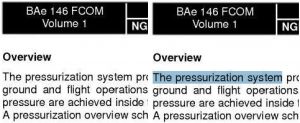 The first things I discovered is that all the manuals were basically images – not embedded text in the PDF document. That meant I could not search, could not copy/paste text, highlight – a nightmare. I set about using Acrobat to OCR all the manuals and embed the text equivalent. This action basically doesn’t change the visual representation of the text but enables Acrobat’s search function and gives you the ability to select an accurate (most of the time) text representation of the screenshot you are looking at. The OCR across the manuals took several hours for my laptop to complete and increased file size about 20%.
The first things I discovered is that all the manuals were basically images – not embedded text in the PDF document. That meant I could not search, could not copy/paste text, highlight – a nightmare. I set about using Acrobat to OCR all the manuals and embed the text equivalent. This action basically doesn’t change the visual representation of the text but enables Acrobat’s search function and gives you the ability to select an accurate (most of the time) text representation of the screenshot you are looking at. The OCR across the manuals took several hours for my laptop to complete and increased file size about 20%.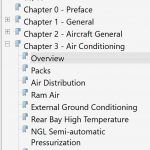 The next problem was that the PDF Table of Contents (called Bookmarks in Acrobat) was filled out to the first level, and that was all. So I could browse to the Air Conditioning section, but it I wanted to use a Table-Of-Contents style browse lower down, that was it. So as I start working with each manual I spent a hour or so building out the TOC/Bookmarks a further two or three levels.
The next problem was that the PDF Table of Contents (called Bookmarks in Acrobat) was filled out to the first level, and that was all. So I could browse to the Air Conditioning section, but it I wanted to use a Table-Of-Contents style browse lower down, that was it. So as I start working with each manual I spent a hour or so building out the TOC/Bookmarks a further two or three levels.
These actions serve the useful function of delaying the actual study program enough for you to be (more) mentally prepared for the actual activity of studying.
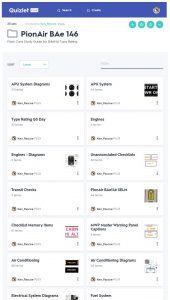
CBT …. Zip
While I found some CBT on YouTube – it’s for the Rejional Jet (RJ) version of the aircraft which is the BAe146 corrected for earlier shortcomings. BAe146 with FADEC; BAE146 with AutoThrottle; BAe146 with Autoland. BAe146 with Digital Engine Instrumentation. BAe146 with EFIS. So while the CBT gave me some background – in the end it also had some contradictions which didn’t help …
Preparation – Quizlet
I was casting around for some kind of tool to assist with creating memory and recall. I finally settled on Quizlet. As I prepared for the course I set about making a set of long term notes and revision material that I can come back to over my life on the aircraft to keep on top of systems, factoids, checklist memory items, limitations, etc. I included images in these to try and keep the interest up. If you want to look through them, you’ll find them at the following link:
https://quizlet.com/Ken_Pascoe/folders/pionair-bae-146?x=1xqt&i=2zvi4h
Some more points about the BAe146 …
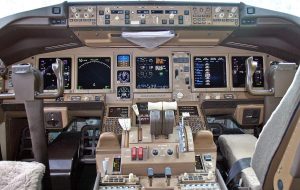 It’s British!
It’s British!
Look I don’t mean to be negative about the British. Quite frankly I think best British TV is superior to practically anything else, with some notable exceptions. Having flown both Airbus and Boeing in my past – I know that:
- When want to turn something ON in an Boeing – you reach up and flick the switch FORWARD.
- When you want to turn something ON in an Airbus – you reach up and flick the switch BACKWARD.
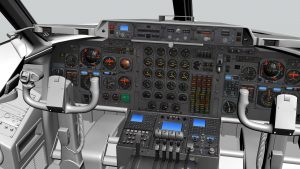 As a pilot – I’m used to this shit. Why can’t these two get together? As to the BAe146 …
As a pilot – I’m used to this shit. Why can’t these two get together? As to the BAe146 …
Yeah there’s no pattern there. Some switches are 2 and some are 3 positions. Those positions include ON, OFF, AUTO, SHUT, OPEN, NORM, START, STOP, FAST, SLOW – if you can think of it, the BAe146 has a switch/position for it. And in many cases ON is one direction for one switch but in the middle or the other direction for another switch not that far away on the overhead panel. Far Out.
I’m reminded of that story where a brand new Cabin Crew member walks onto the flight deck and tells the Captain how in awe she is that he knows what all the switches and buttons do.
“What switches and buttons do you mean?” he queries?
She points to the roof and says “Well, all those for a start.”
The Captain looks lazily upwards, his eyes widen in fear and he says “Good Lord – what on earth are all those for?“
All of this is part and parcel of converting from one flight deck to another, as you can see here.
There are Diagrams!
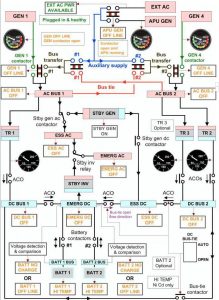
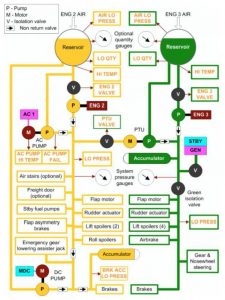 20+ years ago I flew the Airbus A310/A300. Now THAT manual had diagrams. The 777 – not so much. But look out – here comes the BAe146.
20+ years ago I flew the Airbus A310/A300. Now THAT manual had diagrams. The 777 – not so much. But look out – here comes the BAe146.
And again – it’s not about complexity. The 777 is an incredibly complex aircraft, as all modern aircraft are. It’s just that the manufacturer made a conscious decision to identify what pilots needed to know; what might be nice to know – but more particularly, what we do not need to know – and then they decided not to tell us that.
My impression of the BAe146 FCOM is that no-one ever took on that task. There is shite in the BAe146 FCOMs that I suspect pertain to aircraft that ceased to exist before the commencement of this century.
Flying an Older Plane
Part and Parcel with flying older aircraft comes a few changes for it’s pilot:
- Design Philosophy
- Redundancy
- Complexity in the provision of information
- Diagrams! Did I mention the Diagrams?
- Checklist Memory Items! Lots of them!
- Lack of updates
- Multiple Models
This last part is important as well. There are at least three models of the BAe146 (-100; -200; -300) and then there are QT (Quite Trader, the Freighter); QC (Quick Change – between Pax and Freight); and the pure Pax version. So in the worst of all possible cases – six different types of BAe146 to know. Except that it seems like almost every BAe146 is different to the next one, even if they’re the same model/config. And then some have thin generator cables and so certain electrical switches are limited in their use – and some do not. Everything from Airspeed/Altitude limitations through to procedures vary depending (almost) on the specific aircraft (Registration). It’s fair to say that at this point – that’s just scratching the tip of the iceberg.
…
The Upshot
In the end I completed my Type Rating successfully; then the Instrument Proficiency Check (which was an event all of itself); followed by the Operator Proficiency Check. It’s on my licence and now I’m officially a British Aerospace 146 Captain. Or at least – I will be when I can find one. Standby by for the details and photos of my first flight.
Ken.
If you find my content useful and are in a position to do so – I would appreciate a contribution to my PayPal account (ken.pascoe@gmail.com) – If you use the Friends and Family feature in PayPal it reduces the charges to the transfer. Please note that when sending money in this way you are removing any form of purchase protection, which is not relevant to a contribution of this type anyway.
Regards, Ken Pascoe
